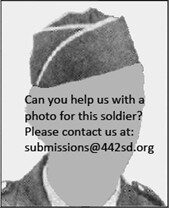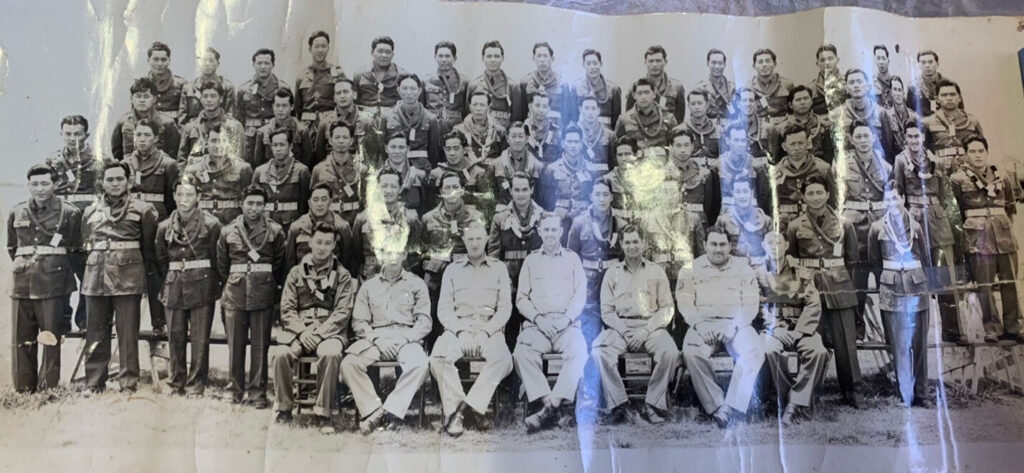Soldier Story: Frank Morita Nishimura
Soldier Story

Frank Morito Nishimura
Private
100th Infantry Battalion (Separate)
Headquarters Company
Frank Morito Nishimura was born on June 2, 1918, in South Hilo, Hawaii island, Territory of Hawaii. He was the second child of Nihei and Miki (Tsuchimura) Nishimura. Nihei emigrated from the village of Kashima, Kumamoto Prefecture, Japan, arriving on October 5, 1906, on the S.S. Doric at the age of 19. Miki arrived from the village of Oshima, Kumamoto Prefecture, at the age of 20 on April 5, 1914, on the S.S. Manchuria, and married Nihei six days later.
At the time of Frank’s birth, his elder sibling had died. The family was living at Kanai Camp in Waiakea and his father was a stevedore. His siblings were: brothers Makoto and Andrew Akito; and sisters Alice Mitsue and Doris Tsutoe.
By 1920, the family had moved to Oahu, where father Nihei worked on the sugar plantation in Ewa. By 1930, the family was living on the leeward side of Oahu in Kailua and Nihei operated a fruit farm. By April 1940, they were living in the Maunawili area of Kailua. Nihei was a fruit farmer and the two eldest sons, Morito and Makoto, were his helpers.
Frank Nishimura signed his draft registration card on October 26, 1940, Local Board No. 1, Kaneohe Courthouse, Kaneohe, Oahu. His address was P.O. Box 36 in nearby Lanikai and his point of contact was a friend, Masatoke Tashiro, of Lanikai. He was employed by general contractor J.M. Tanaka at University Avenue and Kalo Lane in Honolulu. He was 5’5” tall and weighed 150 pounds.
On June 20, 1941, Frank was notified by his draft board to report to Schofield Barracks for induction in ten days. Frank enlisted in the U.S. Army on June 30, 1941. His civilian occupation was listed as “Semi-skilled chauffeur/driver, bus, taxi, truck, tractor.” He had completed grammar school, was 5’5” tall, and weighed 151 pounds. He was sent to Schofield Barracks for a 3-month intensive training period.
On September 27, 1941, Nishimura was among the third group of Selective Service men who were welcomed into the 298th Infantry Regiment (formerly the Hawaii National Guard). He was assigned to Service Company and stationed at Schofield Barracks. The 298th was housed in tents in the area of Schofield Barracks known as Boom Town.
Photo below: 298th Infantry Regiment, Service Company, at Schofield Barracks in 1941. Private Nishimura’s location in the photo has not been identified.

Following the attack on Pearl Harbor, the 298th Regiment with its many Nisei soldiers, including Frank, continued to serve in guarding Oahu from enemy attack. In May 1942, Lt Gen. Delos Emmons, the Commanding General of the Hawaii Department, recommended to the Secretary of War that the Nisei of the 298th and 299th Infantry Regiments be sent to the Mainland for training. In late May, General George Marshall, the U.S. Army Chief of Staff, ordered that these Nisei soldiers be formed into the Hawaiian Provisional Infantry Battalion and sent to Camp McCoy, Wisconsin for infantry training. A few Nisei soldiers who were in the 3rd and 65th Engineers Combat Battalion of the 24th Infantry Division were also included in this new battalion.
Frank Kawamoto was one of the 1,432 soldiers assigned to the Hawaiian Provisional Infantry Battalion.
On June 5, 1942, the battalion was sent to Oakland, California, on the USAT Maui. Upon arrival, their unit was given the name 100th Infantry Battalion and sent to Camp McCoy, Wisconsin, on three separate trains taking different routes. After arriving at Camp McCoy, the unit was redesignated the 100th Infantry Battalion (Separate).
Following intensive training at Camp McCoy, on January 6, 1943, the battalion was sent to Camp Shelby, Mississippi for training involving fighting as a battalion of a regiment or larger formation. Finally, with training over and in preparation for shipment to the combat theater in Europe, the men were given medical exams to confirm each soldier was ready to go. However, Private Frank Kawamoto did not pass this medical exam and was transferred to the 442nd Regimental Headquarters Company, along with five other soldiers who also did not pass the exam. The 100th Battalion departed for the war in August 1943, and on October 9, 1943, Frank was discharged from the U.S. Army and returned home to Oahu.
After his return, Nishimura officially had his name changed from Morito Nishimura to Frank Morito Nishimura, by order of the Acting Governor of the Territory of Hawaii, Ernest K. Kai.
For his World War II service, Pvt. Frank Morito Nishimura earned the following awards: Good Conduct Medal, Asiatic-Pacific Service Medal, and World War II Victory Medal.
On April 5, 1945, Frank M. Nishimura of Kailua married Kimie Kimura of 1493 South King Street in Honolulu. By 1950, the family was living at 975-C Kaheka Lane in Honolulu. Frank was an auto mechanic for the U.S. Navy.
In 1951 their house in Kailua was built on Lot 904 by Sumida & Tanaka. The address was 439 Keaniani Street. Over the years they raised a family of two sons and one daughter. They belonged to Club 100 (100th Infantry Battalion Veterans Club) and Kailua Hongwanji Mission.
Frank’s wife, Kimie Nishimura, died on December 24, 1981, in Kailua. Frank Morito Nishimura died at the age of 90 on November 11, 2008, at Ohana Care Home in Honolulu. He was a retired federal government auto mechanic. Nishimura was survived by two sons and one daughter, five grandchildren, and his sister Doris. Funeral services were held on November 30 at Hosoi Garden Mortuary in Honolulu. They were inurned on September 8, 2022, at the Hawaii Memorial Park Cemetery in Kaneohe.
Researched and written by the Sons & Daughters of the 442nd Regimental Combat Team with assistance by the family in 2022 and updated in 2025.